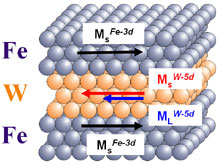Presentation
Beamline ID12 is dedicated to polarization-dependent X-ray absorption and excitation spectroscopies in the energy range 2.0 < 
 < 20 keV. It complements the new ESRF beamline ID08 which is similarly dedicated to polarization-dependent spectroscopies, but in the soft X-ray range. Historically, these two beamlines (ID08 and ID12) share a common origin (i.e. the ESRF "Beamline-06" project initiated by J. Goulon): they coexisted on the same straight section (ID12) of the machine for several years. Today, beamline ID12 is the upgraded version of the high energy branch ID12-A, whereas the Dragon spectrometer of the soft X-ray side-branch ID12-B has been re-installed on another straight section (ID08) of the storage ring.
< 20 keV. It complements the new ESRF beamline ID08 which is similarly dedicated to polarization-dependent spectroscopies, but in the soft X-ray range. Historically, these two beamlines (ID08 and ID12) share a common origin (i.e. the ESRF "Beamline-06" project initiated by J. Goulon): they coexisted on the same straight section (ID12) of the machine for several years. Today, beamline ID12 is the upgraded version of the high energy branch ID12-A, whereas the Dragon spectrometer of the soft X-ray side-branch ID12-B has been re-installed on another straight section (ID08) of the storage ring.

The main specificity of beamline ID12 is that the users have full control of the polarization state of the incident X-ray beam over a wide energy range. Either circularly or linearly polarized X-ray photons can be generated by any one of the three helical undulators installed on the ID12 straight section: HELIOS-II, APPLE-II and the so-called "ElectroMagnet/Permanent magnet Hybrid Undulator" (EMPHU) that have been optimized to complement one another. The principal characteristics of the helical undulators installed on the straight section ID12 are listed in the table.
| Undulator | APPLE-II | HELIOS-II | EMPHU |
| Magnetic Period | 38 mm | 52 mm | 80 mm |
| Number of periods | 42 | 31 | 19 |
| Photon Energy (1st harmonic) | 5 - 9.1 keV | 3.16 - 6.2 keV | 1.6 - 4.35 keV |
| Brilliance | 6.2x1019 | 2.6x1019 | 1.0x1019 |
| Helicity reversal time | < 5 sec | < 5 sec | ~ 160 msec |
In order to preserve the excellent performances of the sources, various optical components of the beamline were designed with emphasis being laid on stability and on problems associated with either the control or the conversion of the polarization of the X-ray beam.
The key component of the beamline is the UHV compatible double-crystal, fixed-exit monochromator, which is typically equipped with a pair of Si<111> crystals cooled down to -140°C. Unfortunately, the polarization transfer function of a double-crystal monochromator is not constant and strongly varies with the Bragg angle. For a circularly polarized incident beam, the circular polarization rate ( ) of the monochromatic beam can be expressed as:
) of the monochromatic beam can be expressed as:

where Si are the Stokes parameters of the incoming X-rays and | σπ |2 is the crystal reflectivity for the σπ component. An unusual feature of the monochromator is the possibility to rotate the whole instrument around the beam axis (+/-48°). This option is essential for polarimetry measurements at Bragg angles approaching 45° because the monochromator acts as a linear polarizer.
σπ |2 is the crystal reflectivity for the σπ component. An unusual feature of the monochromator is the possibility to rotate the whole instrument around the beam axis (+/-48°). This option is essential for polarimetry measurements at Bragg angles approaching 45° because the monochromator acts as a linear polarizer.
All fluorescence detectors, intensity monitors or beam position monitors installed at the beamline are (single- or multi-anode) ion implanted silicon photodiodes. The arguments which led us to prefer photodiodes are well known: (i) their high efficiency in the X-ray range; (ii) their fast response time; (iii) their excellent linearity. Moreover, photodiodes not only offer the great advantage to be fully UHV compatible but are also nearly insensitive to magnetic fields and that is a substantial advantage for XMCD experiments. One can get rid of the temperature dependent dark current by exploiting a synchronous detection technique based on a square wave modulation of the X-ray beam.
Regarding the scientific projects run on beamline ID12, we wish to emphasize that the ID12 team has contributed to significant advances in a rich variety of X-ray dichroisms which refer to:
- X-ray magneto-optical effects: X-ray Magnetic Linear Dichroism (XMLD); X-ray Magnetic Circular Dichroism (XMCD); X-ray Resonant Magnetic Scattering (XRMS));
- X-ray Optical Activity: X-ray Natural Circular Dichroism (XNCD), X-ray Magnetochiral Dichroism (XM
 D), Non-Reciprocal X-ray Magnetic Linear Dichroism (NR-XMLD)).
D), Non-Reciprocal X-ray Magnetic Linear Dichroism (NR-XMLD)).
Recall that the existence of reciprocal/non-reciprocal optical activity in the X-ray range has been established by experiments proposed by the ID12 team and carried out on this beamline.



